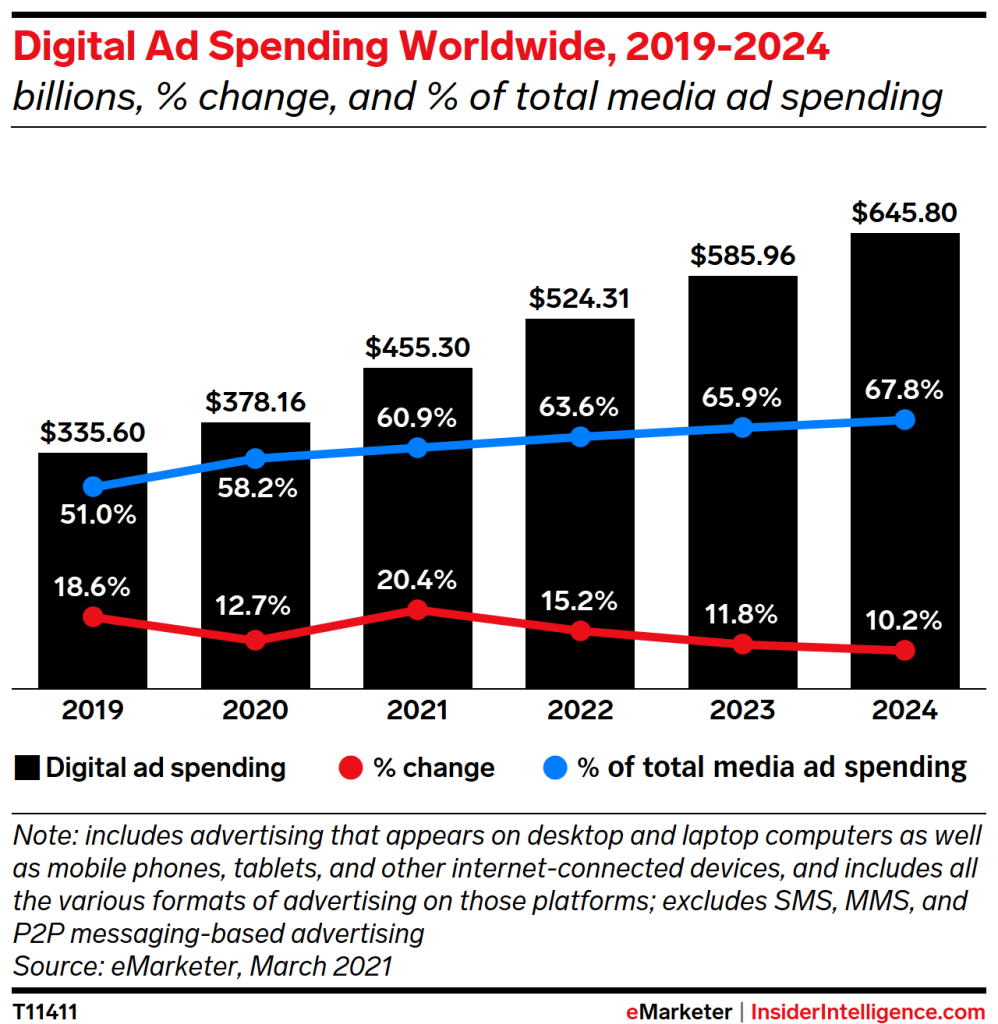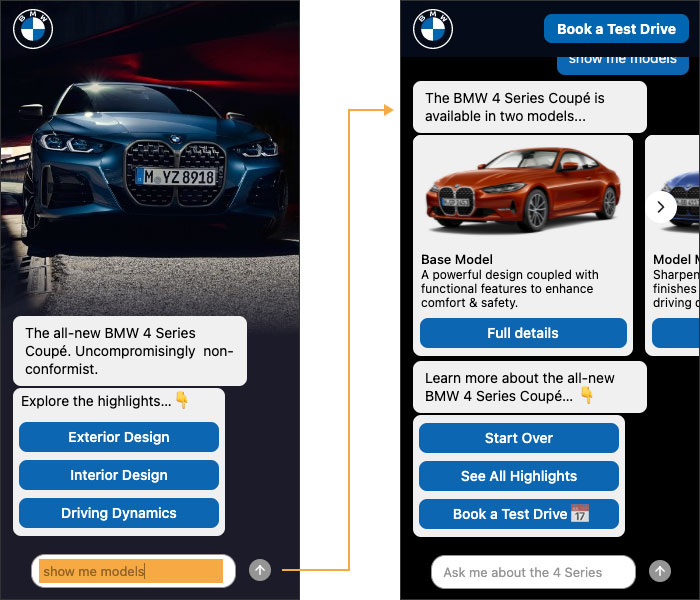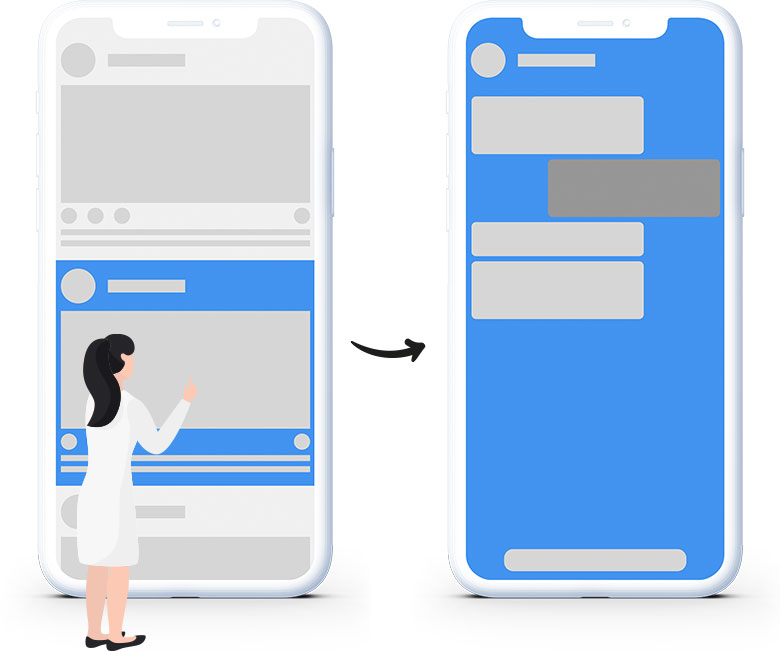Want to unlock the true potential of your programmatic and social ads? Look no further. This guide is the ultimate tool for mastering conversational advertising in 2024.
From understanding the fundamentals to putting it into action, we’ll provide you with the knowledge and strategies you need to drive higher engagement and boost your ROI. Say goodbye to boring programmatic display ads and static landing pages and hello to the future of advertising.
Want to dive into a specific topic? No problem; we’ve included a table of contents to help you navigate the guide with ease. Don’t miss out on this opportunity to take your advertising game to the next level. Keep reading to discover the power of conversational advertising.
Part 2: What is Conversational Advertising?
Part 4: Conversational Programmatic Display Ads
Part 5: Conversational Social Campaigns
Part 6: Measurement and Analytics
Part 1: How Did We Get Here?
Here’s a simple question: Is this what online advertising would look like if the customer experience came first?



Are you tired of the same old digital ads that lack engagement and leave consumers feeling tricked? You’re not alone. Traditional digital ad formats like banner ads no longer cut it. In fact, a recent study found that only 7% of people who clicked on an ad did so because it was compelling.1
Check out some of these stats:
Source: HubSpot, “Why People Block Ads (And What It Means for Marketers and Advertisers”, 2016/20181
Of people who have clicked on an ad, 34% said it was a mistake, and 15% accused advertisers of tricking them into clicking.1
27 years after the first banner, we have…pretty much the same banners.
It’s time for a change. The media world has evolved dramatically, but the creative formats and user experiences in advertising have remained stagnant. This is leading to banner blindness and a lack of engagement from consumers.
Some of these formats undoubtedly work for some brands. But the consumer engagement numbers don’t lie.
Here’s why these ‘industry standards’ don’t work:
The really crazy thing? This isn’t just bad for consumers. It’s terrible for advertisers too! Yet look at the current and projected ad spend:3

There is a solution. Conversational advertising offers a new approach that prioritizes the customer experience and breaks away from the reductive and outdated industry standards. It’s a game-changer for both consumers and advertisers alike. Don’t settle for mediocre results any longer. Discover the power of conversational advertising and take your campaigns to the next level.
Part 2: What is Conversational Advertising?
Conversations are how we naturally engage with each other. Written or spoken, they are our primary form of communication.
Plus, conversations (at least those that we willingly engage in) tick the boxes of what online advertising should do:
Conversational advertising is a new approach to digital advertising that can utilize AI and conversational interfaces to engage with consumers in a more natural and personalized way. Instead of being bombarded with traditional banner ads, consumers are invited to interact with the brand in a conversational manner, allowing for more meaningful interactions and better customer experiences.
One of the main benefits of conversational advertising is its ability to increase engagement. By using conversational interfaces, brands can create a more personalized and interactive experience for consumers, leading to higher levels of engagement and brand loyalty.
Another benefit is the ability to collect valuable data. As consumers interact with the brand through conversational interfaces, brands can gather valuable information on consumer preferences and behavior, allowing them to better target and personalize their advertising efforts.
Conversational advertising also has the potential to improve the customer journey. By providing consumers with quick and convenient access to the information they need, brands can help streamline the purchasing process and make it easier for consumers to find and buy products.
Conversational advertising is a powerful tool that can help brands increase engagement, gather valuable data, and improve customer journeys. It offers a new and exciting way to connect with consumers in a more natural and personalized way.
Here’s how it works…
Automated conversations (those powered by machine learning and natural language processing) are made up of ‘intents,’ which are the basic building blocks of a conversation.
Every intent has two parts:
Here’s a simple example of what an intent for an automotive conversational ad might look like if a user asks about available models…

Utterances in conversational ads are text-based (by clicking a button or typing in a question), but they can also be voice-based, particularly with mobile devices. Responses can be delivered back to the user as any combination of images, text, cards, and buttons – or specialized custom-built response formats.
At its most basic, a conversational ad is a bunch of intents that together help consumers get relevant information about a brand/product/service in a natural, conversational way.
Of course, things can get more involved – for example, if you’re collecting leads, allowing users to upload images, or pushing consumers down a specific path/funnel.
Now that we have a basic idea of how automated conversations work, let’s explore why these experiences engage consumers.
Part 3: Why Does Conversational Advertising Work?
Messaging is the #1 preferred format for consumers when engaging with a brand. Here’s why…

It’s no longer about a ‘one size fits all’ ad. Conversational ads deliver personalized, highly relevant content in a naturally engaging way.
Now let’s look at the different ways conversational advertising can be brought to life.
Part 4: Conversational Programmatic Display Ads
Conversational programmatic display ads combine ad creative using conversational interfaces with programmatic advertising. Programmatic advertising is a method of buying and displaying digital ads through automated systems and algorithms, allowing for highly targeted and efficient ad delivery.
Conversational programmatic display ads utilize the efficiency of programmatic buying to deliver personalized and interactive ads to consumers. This allows brands to engage with consumers more naturally and personally, leading to higher engagement and better targeting.
The key benefits of conversational display ads are:
With that, let’s look at bringing conversational advertising to the ‘walled gardens’ of social apps to get more out of social campaigns.
Part 5: Conversational Social Campaigns
magine triggering an in-app conversational experience on platforms like Twitter, Facebook, Instagram, and LinkedIn.
By using conversational interfaces, your social ads can provide a more personalized and interactive experience for consumers, leading to higher levels of engagement. In addition, this conversational experience feels like a natural extension of the social platform and is a less disruptive browsing experience.
For all social platforms, the conversational experience gets triggered by the user clicking an ad (i.e., a feed ad or story ad) – essentially any ad format that provides a click to an advertiser’s page. The difference is that instead of loading a static, ‘one-size-fits-all’ landing page, the social platform’s in-app browser loads a conversational experience that provides all of the benefits of conversational advertising, in addition to feeling more ‘native.’
Overall, it allows for a more seamless and personalized experience. The entire customer interaction can remain in the chat, or consumers can jump over the advertiser’s site at appropriate times in the conversation.
Replace Static Landing Pages With Conversations
Most social ads direct users to a static landing page on click. And often, these landing pages are a ‘wall of text’ that the advertiser hopes the consumer is interested in reading.
Therein lies the problem. It’s just not realistic to expect that every consumer is going to get the information they want or need from the same static landing page.

By replacing these static pages with in-app conversations, the ‘one size fits all’ nature of the experience is gone – and replaced with something engaging, highly personalized, and non-disruptive.
Part 6: Measurement & Analytics
Conversational advertising campaigns provide a wealth of data collection capabilities that can be used to gain a deeper understanding of consumer preferences and behavior. This data can then be used to improve targeting and personalization, leading to better campaign performance and higher ROI.
Some of the data that can be collected through conversational advertising campaigns include:

Measuring Conversation Flow in Conversational Ads
Conversation Flow measures interaction on an aggregate level, breaking down the most popular areas of interest. In the diagram below, we can explore various paths that users have taken through the experience before either leaving the conversational experience via clicking on an exit URL or leaving the session.
By leveraging these measurement and analytics capabilities, brands can gain a deeper understanding of consumer behavior, improve targeting and personalization, and optimize their campaigns for better performance and ROI.
Part 7: Future Formats
Conversational advertising has the potential to be a powerful tool for emerging ad formats such as connected TV. As more and more consumers are streaming content on connected TV devices, brands are looking for new ways to reach and engage with this audience.
One way that conversational advertising could be used in connected TV is through the use of voice-activated product demonstrations, personalized recommendations, and interactive quizzes.
Another way conversational advertising could be used in connected TV is through the use of interactive ads that allow consumers to engage in a two-way conversation with the brand. This could include things like interactive polls, quizzes, and surveys, which would allow brands to gather valuable data on consumer preferences and behavior.
Additionally, conversational interfaces could be integrated into connected TV apps, allowing brands to interact with consumers more personalized way. This could include things like providing information about new products or learning more about how consumers use their products.
Overall, conversational advertising has the potential to be a powerful tool for brands looking to reach and engage with the connected TV audience. By leveraging conversational interfaces’ interactive and personalized nature, brands can create more meaningful and memorable experiences for consumers.
Conclusion
Conversational advertising is one of the best ways to generate a positive return on ad spend (ROAS), whether you’re building a brand, launching a product or service, generating leads, or remarketing.
It’s a highly engaging format that allows consumers to self-select the content they’re interested in, increasing the likelihood that they will engage and walk away from the experience better-informed.
Interested in learning more? Book a demo to see how AdChat’s conversational ad platform can bring it all to life.
Sources
2 https://www.adobe.com/advertising/25th-anniversary-digital-ad.html
3 https://www.emarketer.com/content/global-digital-ad-spending-2019
4 https://chatbotslife.com/messenger-chatbots-the-stats-dont-lie-f8cd640152f1
6 https://theblog.adobe.com/adobe-bets-on-voice/
7 https://venturebeat.com/2018/03/20/taking-command-of-voice-what-the-new-channel-means-for-marketers/



